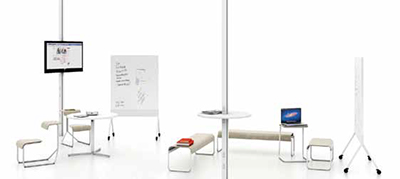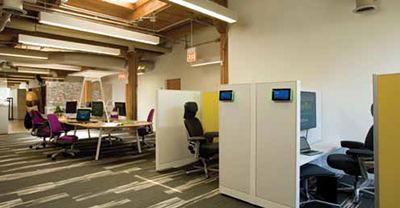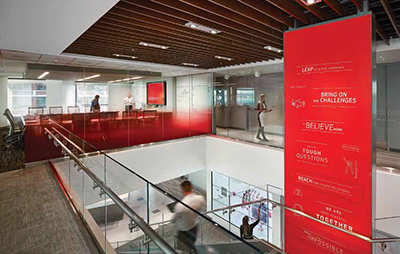The shifting work environment is only getting started
A focus on total cost of ownership will require integrators to quantify the efficiencies offered by AV technology in the new office environment, via the IP address, observed Julian Phillips of Whitlock. Then “every aspect of input/output and customer outcome can be measured, managed, and optimized to deliver far greater efficiency than we deliver today.” The corporate workplace is undergoing a transformation, due in large part to a combination of influences such as cost, collaboration, convergence, and the cloud. What will the future office look like, and what part will AV integrators play in its evolution?
“The workplace is not evolving, it’s being revolutionized,” according to Julian Phillips, executive vice president of Whitlock. “More businesses are moving towards ‘European style’ open plan office environments to make better use of space and create a more collaborative working environment. This drives a need for more informal meeting spaces.
“Research has shown that the average meeting is now with less than four people in the office, although more may join virtually, therefore we are seeing a demand for fewer medium-sized conference rooms for eight to 12 people, but many more ‘huddle’ spaces for four to six people.”
There is another trend, observed Thomas Shen, managing partner at Shen Milsom & Wilke—hoteling, a.k.a. teaming or benching. Instead of each employee having a dedicated cubicle, “It’s a dynamic work environment that allows a user to come in and have a touchdown area.” Using a cloud-based computer or their own device, “They just log in and their profile moves over to that physical workstation, including their phone extension.”
The workplace revolution has been driven partly by the economic downturn and rising real estate costs. One of Shen’s clients is consolidating its Manhattan footprint. “They’re downsizing from three million to two million square feet,” he reported. “But in doing so, they are configuring the office layout to have fewer large private offices, and more open plan workstations. Our client is using the methodology of hoteling so that they can gain better economies of efficiency for the density of their workstations.”
This physical change in the office environment is also being enabled by the more collaborative philosophy of the sector’s fastest-growing workforce, explained Todd McCandless, CTO and principal at WorkLogik: “It’s being driven by Gen Y, the Millennials. In the next decade baby boomers will consist of less than 25 percent of the workforce. Gen Ys will represent over 50 percent; there’s 80 million of them in America. And they like to share common issues or challenges and collaborate on them.”
The roots of the revolution can also be traced to Apple’s elegant, easy-to-use wireless products. “We’ve all gained this intimacy with our mobile devices,” said McCandless. “That intimacy has demanded that the commercial technology industry reckon with it— hence BYOD [bring your own device].”
“People are carrying up to four wireless devices into a meeting room,” said Shen. “The wireless network needs to be able to support the numerous connections that everyone is walking into a room with, and then be able to take that information and share it dynamically with the room.”
One in-room collaborative solution is Barco’s ClickShare, he said. Current trends also include implementation of distributed antenna systems to ensure facility-wide wireless access, and cellular reinforcement systems, especially in high-rises, he added.
“The other really interesting trend is that BYOD is being tied to you as an individual, so that when you come into a particular space that device can be utilized to control the room,” observed Anthony Cuellar, vice president of Diversified Systems. While authentication and security issues remain concerns for the IT department, NFC and RFID technologies are enabling individuals’ devices to be automatically recognized and logged into workplace networks.
Cuellar also noted the increasing adoption of software codecs, enabling videoconferencing via the cloud. “I can videoconference with my team really quickly, in very high resolution, on my iPad or on my desktop. Those kinds of technologies are here today, mature, and working.”

Worklogik’s Todd McCandless points out that in the next decade baby boomers will consist of less than 25 percent of the workforce. Gen Ys will represent over 50 percent, and collaboration is the key to their work ethic. McCandless agreed: “We’re starting to see communications software and apps on mobile devices that are becoming really sophisticated.” Newer Unified Communications services such as Skype, Google Hangouts, and join.me are supplanting legacy voice-over-IP systems, he further noted. “I’ve got clients forklifting entire Cisco UC systems to the curb in favor of [Microsoft] Lync. Nobody wants to buy a $120,000 juggernaut for their conference room.”
Moving applications onto the cloud certainly offers costs efficiencies. “Instead of building large, very expensive, high power-consumption data centers in the corporate environment, they’re moving a lot of that equipment out to the cloud through hosted co-location facilities or off-site data centers,” said Shen.
These remote data centers support very high levels of redundancy and fault tolerance. “They provide higher levels of data availability, and it allows for our clients in the corporate environment to have better space utilization within their very expensive real estate.”
Cloud-based systems can also reduce manpower requirements and enable centralized IT and multimedia control, Shen continued. “Instead of having 20 AV staff running around trying to set up and manage the technology in multiple rooms, the system we design allows this management function to be performed remotely, through a centralized control room.”
In fact, modern corporate building systems may be highly converged on an IT backbone. “Through an intelligent building management system and customized control interface you can control not only your IT network, but also your AV network, and other building functions like HVAC, lighting, and security” he said.
The challenge is to design and build a robust, flexible, and scalable technology infrastructure to begin with, said Shen. “When the technology changes, which it inevitably will in two to three years, you’re basically just doing an equipment replacement, a plug-and-play type of an overhaul, without having to open walls and ceiling to run new cables and provide additional infrastructure.”

The physical change in the office environment is being enabled by the more collaborative philosophy of the sector’s fastest-growing workforce, Generation Y. Companies such as Worklogik, a division of CI Select, are integrating AV technology with modular furniture in these new environments. With convergence driving the workplace transformation, AV integrators had better start learning some new technologies. “AV over the last 15 years has focused on the productivity of meetings in physical space; therefore most integrators have spent most of their time building rooms,” Phillips observed. “The next 15 years will be focused on the productivity of meetings in ‘virtual’ space, therefore integrators need to become experts in mobile technology, networking, cloud services, and remote support.”
“We need to anticipate where the office environment is going to go from a technology standpoint,” said McCandless. “The easiest way to do that is to look at the consumer electronics industry.”
With so many mobile devices in use it is important not to overlook their power requirements, warned McCandless. “We need power; we’re using these things constantly.”
The Edison plug is outdated and USB connectors are not suited to heavy use, he said. “Qi wireless inductance power is a neat system. When Apple or Samsung puts it in their products, then you’ll see it launch.”
So how can AV integrators best sell their clients on the ROI of these new technologies and services? “ROI has been difficult to calculate because it has been virtually impossible to calculate ‘gain,’ because we don’t effectively measure outputs and outcomes from AV technology,” Phillips acknowledged.
“What really needs to happen first is a focus on total cost of ownership [TCO]. In other words, what will this technology cost over its lifetime, rather than just the initial purchase cost.”
Happily, there is a way for integrators to quantify the efficiencies offered by AV technology in the new office environment, via the IP address. “Every single AV asset needs to have one and it needs to sit on and be managed on the network,” said Phillips. “Once this is achieved every aspect of input/output and customer outcome can be measured, managed, and optimized to deliver far greater efficiency than we deliver today.
“If more enterprises were to adopt enterprise management software such as Crestron’s Fusion suite, which measures AV outcomes and energy, then true TCO could be achieved, which would lead to effective ROI calculations.”
Steve Harvey (sharvey.prosound@gmail.com) has been west coast editor for Pro Sound News since 2000 and also contributes to TVTechnology, Pro Audio Review, and other NewBay titles. He has over 30 years of hands-on experience with a wide range of audio production technologies.
What is the most outrageous vision of the office of the future?
A number of factors are changing the way people work and what they expect in office environments. The trend toward open space, the drive to reduce real estate costs, the expectations of the younger workforce, and BYOD all are driving designers, IT, and facility management to rethink how people meet and collaborate in the workspace. New technology, such as wireless content sharing, supports these trends and allows designers to create collaboration environments that include traditional meeting rooms, living office space, and huddle rooms to allow for flexible collaboration options for workers. Sit-to-stand workspace and even treadmills are now seen as options to allow for more flexibility in how people contribute in the new work environment. —David Fitzgerald, Channel Director for North America, Barco
In the future, I see sound masking changing to selective sound masking, where the system is sophisticated enough to know to cancel unwanted sounds, but lets people that need to communicate with one another be heard. —Steve Brooks, Speech Privacy Support Manager, Atlas Sound
Ubiquitous display environments. Wireless media transport coupled with an unprecedented trend towards more pixels-per- penny will mean unfettered deployment of pixels across our work, social, and personal spaces. Envision any surface serving as a display. We each already have a rich set of visual data living in the cloud—videos, images, spreadsheets, 3D models, documents—that make up our individual media-sphere. In a world covered in sharable displays, each of us can easily draw upon our media-sphere for impromptu collaborative conversations, anywhere, on any surface. —Christopher Jaynes, Founder and Chief Technology Officer, Mersive
Set me up with some network-connected display/camera glasses (a la Google Glass) enabled for voice and gesture control, a suite of network based collaboration and productivity apps, and maybe some haptic feedback gloves, and I’m my own office. —Joe Andrulis, Vice President, Marketing, AMX
I envision widespread deployments of direct-field sound masking in the offices of the future. As cube walls crumble, plenums perish, and architects push the design envelope, the demand for non-invasive direct-field sound masking to create a comfortable acoustic environment in the office of the future will grow exponentially. —David Sholkovitz, Director of Marketing, Cambridge Sound Management
The office of the future will be clean, collaborative, integrated, and oriented for wellness. “Benching” will be a trend, where long desks house multiple employees. A focus on health will result in more sit-to-stand desks, especially those with counterbalanced designs for instant, fluid adjustment. Inductive charging solutions that allow phones, tablets, laptops, and Bluetooth accessories to charge and synch without the normal mass of cables will be adopted, creating a seamless work environment. —Pete Segar, Group President, Display Mount Solutions (DMS) of Nortek and CEO of Ergotron
Keep the New Office Sound Masking System Safe

Sound masking systems will likely be a critical part of the office of the future, where open office plans will require creation of comfortable collaborative and private environments. The growing popularity of open-plan office environments will likely trigger increasing demand for sound masking systems, which are designed and installed to create more productive environments with greater acoustical comfort. The systems work by raising the ambient background sound in spaces, masking speech, and thereby creating comfortable collaborative and private environments that can coexist. Speakers in a system that produce a gentle “hush” sound are typically installed within the plenum (the space between the ceiling and the deck above) or in the acoustical ceiling tile facing downwards towards the occupants. However, a system that is not properly installed may put those underneath the system at risk.
Sound masking systems may be a risk for occupants and first responders if the speaker systems themselves are not secure. Building code, and just good installation practice, says that “wires and speakers must be secured” to the deck. We have seen too many speakers cut into the ceiling tile and installed without proper methods—no wire or chain securing the speaker to the deck or tile bridges (a device that allows the weight of the speaker to be secured by the ceiling grid instead of the acoustical ceiling tile). Furthermore, and unfortunately, many installers are either unaware of the code or choose to take their chances without putting in a proper hanging system. These installers are taking a risk with the building inspectors and the safety of the occupants.
Ignorance or unethical business practices based on securing the lowest bid should not put occupants in harm’s way. The National Electrical Code (NEC) spells out the requirements as it relates to installation of equipment and wiring regulations.
Based on the NFPA 70 NEC 2011 Edition, generally, the rule for supporting electrical equipment is that the equipment must be ‘securely fastened in place.’ This phrase means not only that vertical support for the weight of the equipment must be provided but also that the equipment must be secured to prevent horizontal movement or sway.
Sections 300.11(A)(1) and (A)(2) are quite similar. These sections clearly prohibit all types of wiring from being attached in any way to the support wires of a ceiling assembly. Unless ceiling grids are part of the building structure, they, too, are prohibited from furnishing support for cables and raceways.
The general requirement of 334.30 is that the cable be secured. Simply draping the cable over air ducts, rafters, timbers, joists, pipes, and ceiling grid members is not permitted.
The NEC speaks volumes when it comes to proper installation and wiring requirements within the plenum. Acoustical ceiling tile (ACT) manufacturers also help to ensure that their products do not bear any weight by voiding warranties if they are “used to support any other material except fiberglass thermal / sound control insulation.”
Safety of building occupants is not a consideration, it is a requirement. The next time you are looking at an audio or sound masking system where the speakers are being installed in the ceiling tile, ask the question: “Are the speakers and wire of the system going to be properly secured?” Make certain this is part of the specification and scope. People matter and safety is everyone’s business.
—David Smith, Business and Channel Strategy, Lencore
What still demands a hard-wired connection, besides security and encryption applications, in an increasingly wireless office?
While many peripheral devices such as keyboards, mice, and even speakers have shifted to wireless connectivity, the high data rates required for uncompressed digital video displays still require a wired connection. As display technology continues to follow a trend for higher resolutions and data rates (4K and 8K), hard-wired cabling will remain the preferred approach for commercial and mission critical applications for many years to come. —Steven Barlow, President, DVI Gear
Companies are racing to be able to stream more data and content. These demands continue to exponentially increase, and at the same time, this demand is placed directly onto the wireless backbone that services the wireless environment. Wireless is a great convenience, but being able to place a fiber optic cable to a server, data rack, desktop, and to WAP locations will soon not be “future proofing,” as the future is here and those devices, especially the wireless components, will need to have optical connections to allow for the data rates that are here and will be here tomorrow. —Rick Sant, Principal, Cleerline Technology Group
We are seeing a couple of simultaneous trends. End-user devices are moving increasingly toward wireless connections, reducing cabling needs to the workstation. At the same time, corporate expectations for multimedia, including true high-definition video, keep rising. To provide two examples, we see explosive growth in HDMI connectivity for individuals that connect their devices to presentation systems. And we see increasing uses of fiber optic cabling on the corporate campus, both for traditional data uses and also as a conduit for the distribution of high-quality video content for collaborative and one-to-many information sessions. —Fred Morgenstern, Product Manager, Neutrik USA
Continuous improvements in cellular networks, Wi-Fi, and newer technologies, such as Miracast and WHDI, are driving the use of wireless devices in corporate environments. In some cases, these have replaced applications that traditionally used cables. However, somewhat counter-intuitively, this has also spurred the growth of a number of cable solutions. A great example of this is the need for cables used to power, charge, and sync the growing number of phones, tablets, ultra books, and laptops. Another growth area has been cables and devices that make it easy to share content from mobile devices with displays, desktop computers, storage devices, etc. —Garry Dukes, Director of Product Management, C2G
I would have to say HD video and ethernet are the two (other than power, security, and encryption) that demand hard wiring precisely because both applications have high-bandwidth demands. For example, for any business to run RAID drive redundancies, the business is usually transmitting a large set of information to the server and/or network-attached storage (NAS). Especially because very few wireless networks can achieve their “full” data rate, and multiple users each share a portion of the data rate available, so a 54mbps for one user would in theory become 27mbps for two users, and so on and so forth. —Danny Mai, Independent Representative, Network the World (NTW)
Audio products still need to be hard wired. Especially when we are talking about high-quality audio. Sure, there are products that offer audio over Wi-Fi devices, but the quality and reliability are not there for true commercial applications. With regards to audio, the majority of the wiring has remained the same for loud speakers and public address systems. It seems that audio wire has not changed as much as originally forecasted. —Christopher Gazdic, Product Engineer for Gepco Brand, General Cable
